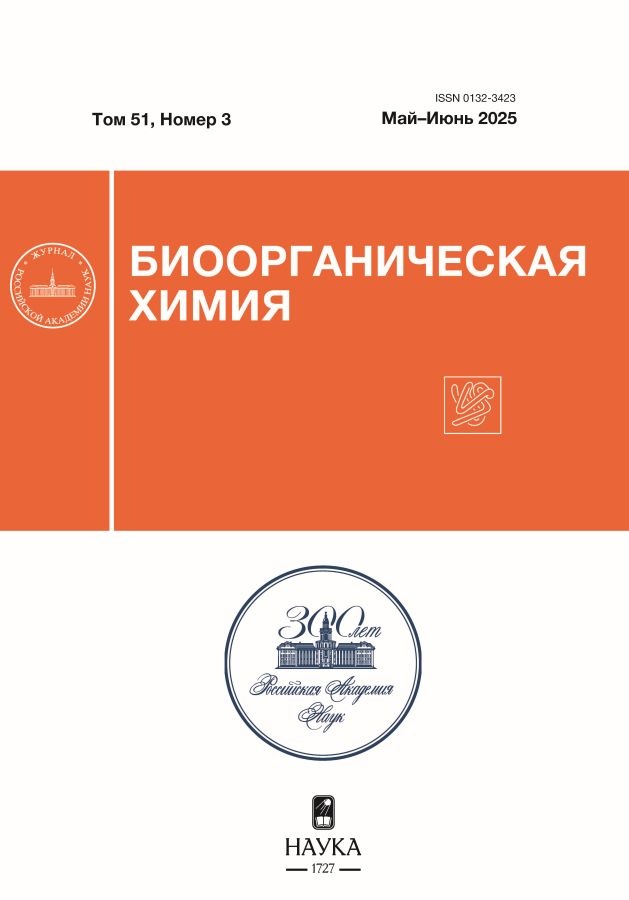TERT promoter mutation analysis in glioma samples by allele-specific biochip hybridization
- 作者: Varachev V.O.1, Barinova I.O.1, Susova О.Y.2, Mitrofanov A.A.2, Surzhikov S.A.1, Grechishnikova I.V.1, Zasedatelev А.S.1, Chudinov А.V.1, Nasedkina Т.V.1
-
隶属关系:
- Engelhardt Institute of Molecular Biology, Russian Academy of Sciences
- N.N. Blokhin National Medical Research Center of Oncology, Ministry of Health of the Russian Federation
- 期: 卷 51, 编号 3 (2025)
- 页面: 531-537
- 栏目: ПИСЬМА РЕДАКТОРУ
- URL: https://ruspoj.com/0132-3423/article/view/687054
- DOI: https://doi.org/10.31857/S0132342325030158
- EDN: https://elibrary.ru/KRXSUM
- ID: 687054
如何引用文章
详细
Somatic mutations in the promoter of the telomerase reverse transcriptase gene TERT can cause reactivation of the telomerase enzyme, which stimulates neoplastic processes in the body. C228T and C250T mutations of the TERT gene promoter (TERTp) are most often found in brain gliomas, for which they are important diagnostic and prognostic markers. To detect TERTp mutations, an approach involving amplification of the promoter region and subsequent hybridization with immobilized probes on a biological microarray (biochip) has been developed. Using this approach, the mutational status of TERTp in 94 glioma samples (astrocytoma, oligodendroglioma, glioblastoma) was investigated. To verify the genotyping results, we used data from Illumina platform targeting sequencing and Sanger direct sequencing. In total, TERTp mutations were detected in 62 of 94 samples (66%), most commonly in patients with glioblastoma (71%). The C228T mutation (69%) was significantly more frequent compared to the C250T mutation (31%). The results of biochip validation on a collection of clinical samples show that it can be used as a convenient and reliable diagnostic tool in genetic analysis of CNS tumors.
全文:
作者简介
V. Varachev
Engelhardt Institute of Molecular Biology, Russian Academy of Sciences
Email: tanased06@rambler.ru
俄罗斯联邦, ul. Vavilova 32, Moscow, 119991
I. Barinova
Engelhardt Institute of Molecular Biology, Russian Academy of Sciences
Email: tanased06@rambler.ru
俄罗斯联邦, ul. Vavilova 32, Moscow, 119991
О. Susova
N.N. Blokhin National Medical Research Center of Oncology, Ministry of Health of the Russian Federation
Email: tanased06@rambler.ru
俄罗斯联邦, Kashirskoe shosse 23, Moscow, 115478
A. Mitrofanov
N.N. Blokhin National Medical Research Center of Oncology, Ministry of Health of the Russian Federation
Email: tanased06@rambler.ru
俄罗斯联邦, Kashirskoe shosse 23, Moscow, 115478
S. Surzhikov
Engelhardt Institute of Molecular Biology, Russian Academy of Sciences
Email: tanased06@rambler.ru
俄罗斯联邦, ul. Vavilova 32, Moscow, 119991
I. Grechishnikova
Engelhardt Institute of Molecular Biology, Russian Academy of Sciences
Email: tanased06@rambler.ru
俄罗斯联邦, ul. Vavilova 32, Moscow, 119991
А. Zasedatelev
Engelhardt Institute of Molecular Biology, Russian Academy of Sciences
Email: tanased06@rambler.ru
俄罗斯联邦, ul. Vavilova 32, Moscow, 119991
А. Chudinov
Engelhardt Institute of Molecular Biology, Russian Academy of Sciences
Email: tanased06@rambler.ru
俄罗斯联邦, ul. Vavilova 32, Moscow, 119991
Т. Nasedkina
Engelhardt Institute of Molecular Biology, Russian Academy of Sciences
编辑信件的主要联系方式.
Email: tanased06@rambler.ru
俄罗斯联邦, ul. Vavilova 32, Moscow, 119991
参考
- Jafri M.A., Ansari S.A., Alqahtani M.H., Shay J.W. // Genome Med. 2016. V. 8. P. 69. https://doi.org/10.1186/s13073-016-0324-x
- Gupta S., Vanderbilt C.M., Lin Y.T., Benhamida J.K., Jungbluth A.A., Rana S., Momeni-Boroujeni A., Chang J.C., Mcfarlane T., Salazar P., Mullaney K., Middha S., Zehir A., Gopalan A., Bale T.A., Ganly I., Arcila M.E., Benayed R., Berger M.F., Ladanyi M., Dogan S. // J. Mol. Diagn. 2021. V. 23. P. 253–263. https://doi.org/10.1016/j.jmoldx.2020.11.003
- Hafezi F., Perez Bercoff D. // Cells. 2020. V. 9. P. 749. https://doi.org/10.3390/cells9030749
- Louis D.N., Perry A., Wesseling P., Brat D.J., Cree I.A., Figarella-Branger D., Hawkins C., Ng H.K., Pfister S.M., Reifenberger G., Soffietti R., von Deimling A., Ellison D.W. // Neuro Oncol. 2021. V. 23. P. 1231– 1251. https://doi.org/10.1093/neuonc/noab106
- Hasanau T., Pisarev E., Kisil O., Nonoguchi N., Le Calvez-Kelm F., Zvereva M. // Biomedicines. 2022. V. 10. P. 728. https://doi.org/10.3390/biomedicines10030728
- Diplas B.H., Liu H., Yang R., Hansen L.J., Zachem A.L., Zhao F., Bigner D.D., McLendon R.E., Jiao Y., He Y., Waitkus M.S., Yan H. // Neuro Oncol. 2019. V. 21. P. 440–450. https://doi.org/10.1093/neuonc/noy167
- Fujioka Y., Hata N., Akagi Y., Kuga D., Hatae R., Sangatsuda Y., Michiwaki Y., Amemiya T., Takigawa K., Funakoshi Y., Sako A., Iwaki T., Iihara K., Mizoguchi M. // J. Neurooncol. 2021. V. 152. P. 47–54. https://doi.org/10.1007/s11060-020-03682-7
- Adachi J.I., Shirahata M., Suzuki T., Mishima K., Uchida E., Sasaki A., Nishikawa R. // Brain Tumor Pathol. 2021. V. 38. P. 201–209. https://doi.org/10.1007/s10014-021-00403-4
- Zacher A., Kaulich K., Stepanow S., Wolter M., Köhrer K., Felsberg J., Malzkorn B., Reifenberger G. // Brain Pathol. 2017. V. 27. P. 146–159. https://doi.org/10.1111/bpa.12367
- Varachev V.O., Guskov D.A., Shekhtman A.P., Rogozhin D.V., Polyakov S.A., Zacedatelev A.S., Chudinov A.V., Nasedkina T.V. // Russ. J. Bioorg. Chem. 2023. V. 49. P. 1137–1142. https://doi.org/10.1134/s1068162023050205
- Иконникова А.Ю., Шершов В.Е., Мороз Ю.В., Василисков В.А., Лапа С.А., Мифтахов Р.А., Кузнецова В.Е., Чудинов А.В., Наседкина Т.В. // Биофизика. 2021. Т. 6. С. 31–39. https://doi.org/10.31857/S000630292101004X
- Yuan Y., Qi C., Maling G., Xiang W., Yanhui L., Ruofei L., Yunhe M., Jiewen L., Qing M. // J. Clin. Neurosci. 2016. V. 26. P. 57–62. https://doi.org/10.1016/j.jocn.2015.05.066
- Huang D.S., Wang Z., He X.J., Diplas B.H., Yang R., Killela P.J., Meng Q., Ye Z.Y., Wang W., Jiang X.T., Xu L., He X.L., Zhao Z.S., Xu W.J., Wang H.J., Ma Y.Y., Xia Y.J., Li L., Zhang R.X., Jin T., Zhao Z.K., Xu J., Yu S., Wu F., Liang J., Wang S., Jiao Y., Yan H., Tao H.Q. // Eur. J. Cancer. 2015. V. 51. P. 969–976. https://doi.org/10.1016/j.ejca.2015.03.010
- Hewer E., Phour J., Gutt-Will M., Schucht P., Dettmer M.S., Vassella E.J. // Neuropathol. Exp. Neurol. 2020. V. 79. P. 430–436. https://doi.org/10.1093/jnen/nlaa004
- Li J., Han Z., Ma C., Chi H., Jia D., Zhang K., Feng Z., Han B., Qi M., Li G., Li X., Xue H. // Ann. Clin. Transl. Neurol. 2024. V. 11. P. 2176–2187. https://doi.org/10.1002/acn3.52138
- Варачев В.О., Сусова О.Ю., Митрофанов А.А., Краснов Г.С., Насхлеташвили Д.Р., Аммур Ю.И., Бежанова С.Д., Севян Н.В., Прозоренко Е.В., Бекяшев А.Х., Наседкина Т.В. // Усп. мол. онкологии. 2024. Т. 11. С. 68–78. https://doi.org/10.17650/2313-805X-2024-11-3-68-78
- Краснов Г.С., Гукасян Л.Г., Абрамов И.С., Наседкина Т.В. // Мол. биология. 2021. Т. 5. С. 829–845. https://doi.org/10.31857/S0026898421050050
补充文件












